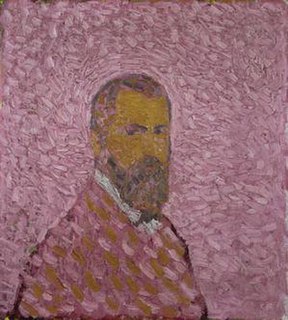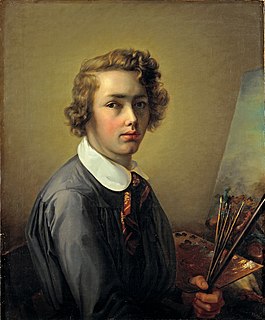
Henry Fuseli was a Swiss painter, draughtsman and writer on art who spent much of his life in Britain. Many of his works, such as The Nightmare, deal with supernatural subject-matter. He painted works for John Boydell's Shakespeare Gallery, and created his own "Milton Gallery". He held the posts of Professor of Painting and Keeper at the Royal Academy. His style had a considerable influence on many younger British artists, including William Blake.

Johannes Itten was a Swiss expressionist painter, designer, teacher, writer and theorist associated with the Bauhaus school. Together with German-American painter Lyonel Feininger and German sculptor Gerhard Marcks, under the direction of German architect Walter Gropius, Itten was part of the core of the Weimar Bauhaus.

Oskar Schlemmer was a German painter, sculptor, designer and choreographer associated with the Bauhaus school.

Max Bill was a Swiss architect, artist, painter, typeface designer, industrial designer and graphic designer.

René Victor Auberjonois was a Swiss post-impressionist painter and one of the leading Swiss artists of the 20th century.
Hans Falk (1918–2002) was a Swiss painter, who lived in New York City, Ireland, England, Switzerland and Stromboli, Italy. Hans Falk was one of the most important modern Swiss painters.

Gunta Stölzl was a German textile artist who played a fundamental role in the development of the Bauhaus school's weaving workshop. As the Bauhaus' only female master she created enormous change within the weaving department as it transitioned from individual pictorial works to modern industrial designs. Her textile work is thought to typify the distinctive style of Bauhaus textiles. She joined the Bauhaus as a student in 1920, became a junior master in 1927 and a full master the next year. She was dismissed for political reasons in 1931, two years before the Bauhaus closed under pressure from the Nazis.

Walter Gramatté was a German expressionist painter who specialized in magic realism. He worked in Berlin, Hamburg, Hiddensee and Barcelona. He often painted with a mystical view of nature. Many of his works were inspired by his experiences in the First World War and his illness.

Giovanni Ulrico Giacometti was a Swiss painter. He was the father of artists Alberto and Diego Giacometti, and architect Bruno Giacometti.

Cuno Amiet was a Swiss painter, illustrator, graphic artist and sculptor. As the first Swiss painter to give precedence to colour in composition, he was a pioneer of modern art in Switzerland.

Serge Brignoni was a Swiss avant-garde painter and sculptor. His collection of ethnic art is now housed in the Museo delle Culture in Lugano.

Rudolf Koller was a Swiss painter. He is associated with a realist and classicist style, and also with the essentially romantic Düsseldorf school of painting. Koller's style is similar to that of the realist painters Gustave Courbet and Jean-Baptiste-Camille Corot. Considered Switzerland's finest animal painter, Koller is rated alongside George Stubbs, Rosa Bonheur and Théodore Géricault. While his reputation was based on his paintings of animals, he was a sensitive and innovative artist whose well-composed works in the "plein air" tradition, including Swiss mountain landscapes, are just as finely executed.
Leo Leuppi (1893–1972) was a Swiss painter, graphic artist, sculptor and representative of the Zürcher Schule der Konkreten. He was a founder of the avant-garde artists' associations Groupe Suisse Abstraction et Surréalisme and Allianz.

Verena Loewensberg was a Swiss painter and graphic designer.

Otto Morach was a Swiss painter and poster artist.
Kurt Oscar Weber was a Swiss-American fine artist, primarily working in sculpture and painting. He worked in several genres of art including German Expressionism, Abstract Expressionism, Color fielding, and Figuration. He is known for his international solo and group exhibitions primarily presented in the US, France, Switzerland, Austria, and Germany. He maintained studios in Emeryville, California and in Uerikon near Lake Zurich for over 30 years.

Johann Victor Krämer was an Austrian painter and photographer, working generally within the Orientalist genre. He was a founding member of the Vienna Secession, and received many awards through his life.

Paul Kayser was a German painter and graphic artist.

Adolf Robbi was a Swiss Impressionist painter.
Marguerite Frey-Surbek (1886–1981), was a Swiss painter and activist.
















